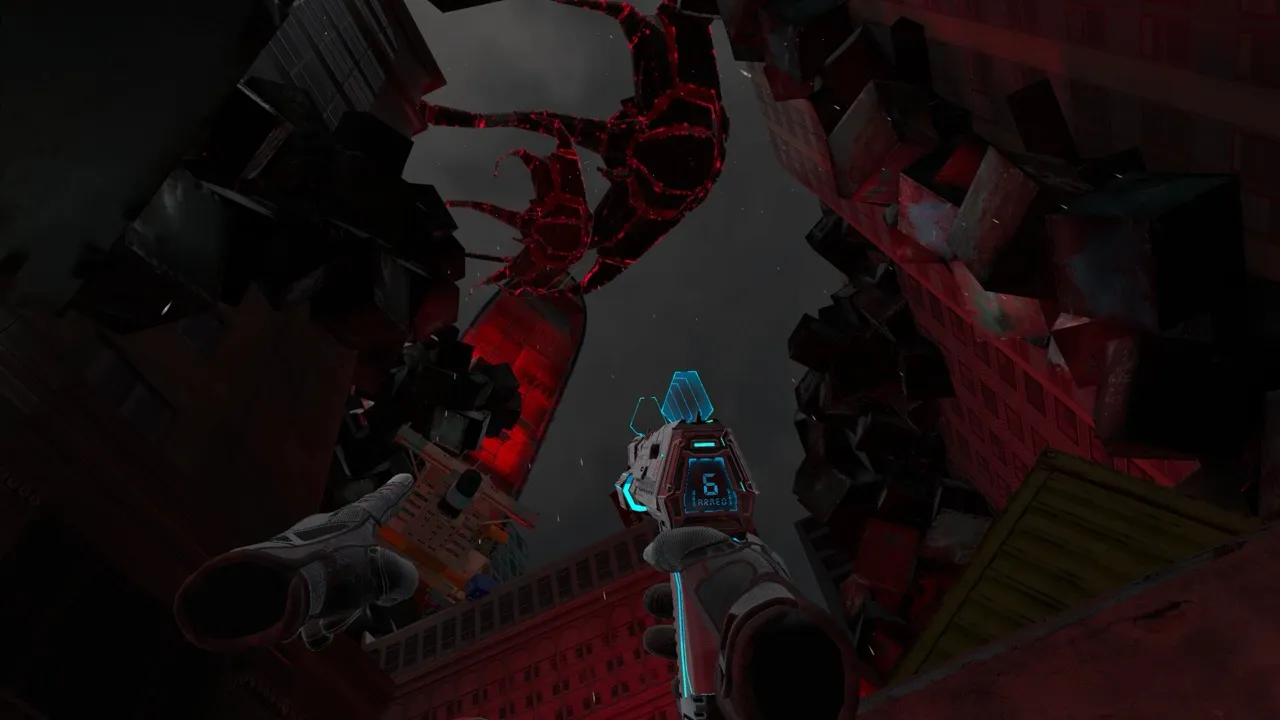Of Lies and Rain may not be perfect, but it is proof that smaller VR projects can punch above their weight when they focus on atmosphere, inventive design and a good balance between story and gameplay
When you first step into Of Lies and Rain on Quest 3, you quickly realize this is a game with ambition. It is not trying to reinvent the wheel with flashy gimmicks or bloated mechanics, but it does attempt to deliver a thoughtful post-apocalyptic story wrapped in atmospheric environments and some surprisingly varied gameplay. Given that the entire experience was built by a very small team, I think it is important to set expectations. This is not a big-budget blockbuster with endless resources, yet it manages to carve out something genuinely engaging.
You play as Adam, the last human brave enough, or foolish enough, to wander outside after the collapse of civilization. The world has fallen to an evil AI that seeks to erase what remains of humanity, while survivors hide away in bunkers and underground settlements. Throughout your journey, you are guided by a voice from one of these hidden enclaves, a constant reminder that you are not completely alone.
The narrative setup is familiar if you enjoy post-apocalyptic tales. Still, Of Lies and Rain makes it work because of its strong atmosphere and commitment to worldbuilding. You uncover notes that fill in the blanks about what happened before you emerged. There are some twists in the story that shake up your perception of the AI threat, and the slow drip of revelations is enough to keep you invested across the six-hour runtime.
Watch this TikTok video
One of the most interesting aspects of the game is its dual structure. On one hand, you move through the ruined real world, exploring metro tunnels, labs, an abandoned school and eventually climb a giant ominous tower. On the other hand, you frequently jack into what the game calls the Data World, a surreal digital battlefield filled with glowing constructs and weird geometry.
In the real world, gameplay is more grounded. You scavenge, explore and fight against mechanical enemies with your standard arsenal: pistol, shotgun and SMG. These weapons can be upgraded using cores you find scattered around the levels. Attachments like scopes, laser pointers and extended magazines give you a sense of progression and add a tangible difference to how combat feels. It is a simple system but effective in rewarding exploration and curiosity.

The Data World is where things shift gears. Here Adam wields a gravity arm cannon that lets him jump to great heights and grapple onto specific spots. He also uses a transforming weapon that can become a crossbow, a minigun or a rocket launcher. Each form feels distinct, and the sound design in particular makes the crossbow incredibly satisfying. The objective in these segments is to clear nodes and fight off AI guardians. Clearing these nodes unlocks pathways in the real world, creating a neat interplay between both realities.
This duality keeps the pacing fresh. Just as you grow comfortable creeping through dusty corridors, you are hurled into the neon void of the Data World where combat is faster and more vertical.

Fighting in Of Lies and Rain is surprisingly fun. The enemy roster may not be massive, but it is memorable. Creepy spider-like bots scuttle around, flying eyeball creatures drift ominously, and later in the game you face towering cone-shaped monstrosities that genuinely feel intimidating.
Gunplay itself feels good, even if weapons lack physical heft. The Quest controllers do not provide the kick you might hope for, but the audio design helps compensate. Reloading is simple and intuitive, and the game uses a virtual inventory wheel that lets you pull out the weapon you need by holding a button and moving your hand in a direction. It works well enough, though I would have loved to see a proper holster system, where you reach to your hip or back to grab your gear. That tactile layer would have pushed immersion even further.
Movement is another highlight. There are numerous climbing sections, from scaling ruined walls to pulling yourself up massive vertical shafts. The physicality of climbing feels great in VR, and the game makes good use of it. Combined with the gravity leaps of the Data World, movement variety is one of the game’s strongest points.

As much as I enjoyed my time with Of Lies and Rain, some design choices left me scratching my head.
The most frustrating mechanic is the toxic rainfall. Outside, there is a constant rain of mercury, and Adam constantly coughs and will die in specific areas unless you use either an inhaler or a gas mask. The gas mask only lasts thirty seconds, or sixty once upgraded and good luck finding any inhalers. Instead of adding tension, this just feels like an unnecessary timer that interrupts the flow. It does not alter your tactics or exploration, it just forces you to stop and fumble with equipment.
Navigation can also be confusing. The game does not hold your hand, which in principle is fine, but at times it is genuinely unclear where you are supposed to go. I can see a lot of players getting lost and frustrated. A subtle breadcrumb system or clearer environmental cues would have helped.

Another missed opportunity is melee combat. The game’s physics engine is robust, letting you pick up most objects and feel their weight, but these items are useless in fights. Even a crowbar, which begs to be swung, is just dead weight. Throwing objects at enemies does nothing, and there are no melee attacks at all. Considering the interactivity of the environment, this absence is disappointing.
Puzzles are another area that feels underdeveloped. Aside from digital hacking mini-games and one clever sequence where you use a pipe through a fence to press a button, there is very little puzzle variety. With such a solid physics system in place, more physics-based puzzles would have been a natural fit.

Visually, Of Lies and Rain is uneven. Some areas are striking, such as metro tunnels overgrown with strange red crystalline growths or the massive corrupted tower. Other environments, however, feel barebones and lifeless, with little detail to hold your attention. The inconsistency makes the presentation hit and miss.
Performance on Quest 3 standalone is another sticking point. The game struggles to maintain smooth framerates, especially in larger environments or during hectic firefights. It is still playable, but it is noticeable, and it does impact immersion. Hopefully future updates can improve optimization.
Sound design fares better. Weapons have satisfying audio cues, enemies make distinct noises that help you track them, and the voice acting is quite strong.

Despite its flaws, Of Lies and Rain succeeds in delivering a compelling VR adventure. The story is engaging enough to keep you moving forward, the dual-world structure keeps gameplay fresh, and combat against its strange roster of robotic enemies is consistently entertaining. The climbing and movement systems also shine, making you feel physically present in a crumbling world.
Yes, the game stumbles. The toxic rain mechanic feels more like an annoyance than a challenge. The lack of melee combat is a puzzling omission. Performance is rough around the edges, and some environments look bland. But these shortcomings do not erase the fact that this is a creative and ambitious VR title built by a tiny team.
If you go in with expectations set correctly, you will find a six-to-eight-hour campaign that offers plenty of memorable moments. Jacking into the Data World to unleash a rocket barrage, scaling a tower as the rain lashes around you, or simply creeping through a forgotten school while your guide whispers in your ear all leave an impression.
Of Lies and Rain may not be perfect, but it is proof that smaller VR projects can punch above their weight when they focus on atmosphere, inventive design and a good balance between story and gameplay. On Quest 3, it is a journey worth taking. Thanks for reading!
The game was reviewed on a Quest 3 via a promo copy provided by the developer. Of Lies and Rain is available on Meta Quest.





